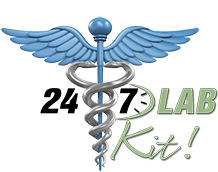Herpes, Ingrown Hair, or Monkeypox? How to Know the Difference
A new bump or lesion can be understandably concerning in a world full of various skin issues and conditions. Whether on or inside your mouth or on your genitals, knowing what Herpes, Monkeypox, and ingrown hair look like can prevent unnecessary panic and let you know when it’s time to look into an online STD testing kit. This is especially useful today as we are seeing a rise in Monkeypox diagnoses, which can also give the appearance of the herpes virus.
Rather than dealing with the anxiety of not knowing the next time you find a sore on your mouth or genitals, use this guide to effectively recognize the difference between Herpes, ingrown hair, and Monkeypox.
What is Herpes and What Does it Look Like?
When deciding whether a new bump or sore is Herpes, there are a few things to take into consideration, including their appearance, discharge, and location. But first, what is Herpes? Herpes is one of the more common STDs with 572,000 new cases in the United States each year. It presents itself in sores on the mouth and/or genitals that can often be both annoying and painful. It is caused by two different (but similar) viruses, including Herpes Simplex virus type 1 (HSV-1) and Herpes Simplex virus type 2 (HSV-2).

These viruses can cause sores to occur on and around the vulva, vagina, cervix, anus, penis, scrotum, butt, inner things, lips, mouth, throat, and occasionally, the eyes. Most commonly spread through skin-on-skin contact with infected areas, typically during vaginal, oral, and anal sex, as well as kissing, herpes can be spread even without showing sores or symptoms. That’s why we must know what we’re looking at in terms of the appearance AND symptoms of Herpes.
So, how can you identify Herpes without immediately testing? Herpes sores look like yellow, red, or white translucent sores or bumps that are filled with a clear liquid. Herpes rashes typically occur in cycles of 2 weeks, including the appearance, growth, and eventual rupturing that results in ulcer-like scabs. They usually show up on the mouth and genital regions, including the buttocks, rectum, genitalia, cervix, and thighs.
Common Herpes Symptoms:
- Pain or itching
- Ulcers
- Scabs
- Small red bumps or tiny blisters on the mouth or genitals
How to Tell if It’s an Ingrown Hair or Herpes
While herpes is common, so too are ingrown hairs. So, the next time you fool around with someone new and discover a sore the following week, keep that in mind before going into an immediate panic. Ingrown hair is caused by shaving, tweezing, or waxing, so they commonly pop up on the legs, genitals, and face in the form of red, tender bumps. If you’re asking yourself, can ingrown hair resemble Herpes? The answer is yes–at first.

When the hair is removed, it can sometimes grow back in an unusual direction, failing to break through the skin and becoming ingrown. Sometimes, when a hair follicle is blocked, it can result in an infection that causes pus to fill the bumps, ultimately creating discharge and discomfort. Unlike herpes, however, ingrown hairs typically occur as isolated lesions, never really appearing in clusters.
When looking at an ingrown hair closely, you’ll see a thin line in the center–that’s the hair beneath the skin. If you found a bump or two and you think they might be ingrown hairs, the good news is that they go away on their own, either after breaking through the skin or being removed.
Common Ingrown Hair Symptoms:
- Small, swollen bumps where you shave, tweeze, or wax
- Blisters filled with pus
- Burning or stinging
- Itching
- Hair appearing in the shape of a loop
What About Monkeypox?
With several Monkeypox cases popping up worldwide, it’s important to educate yourself on what it is and what it looks like – especially since the rash it produces can easily be mistaken for herpes. Caused by the Monkeypox virus, Monkeypox or MPV is a virus in the same family as Small Pox, although much less serious. Its name is a result of the ‘pox’ or outbreak of lesions that can spread from the face to the rest of the body–genitals included.

In terms of spreading, Monkeypox is thought to spread through direct contact with infectious rashes, scabs, and sores. Likewise, the virus can be spread through extended skin-on-skin contact like sexual intercourse, in addition to activities like cuddling, kissing, or simply touching parts of the body affected by Monkeypox. Despite popular belief, while it might appear similar, Monkeypox is not a Herpes virus.
Unlike Herpes, this virus can make you sick with flu-like symptoms. In turn, it is unlikely to go unnoticed like Herpes often does. Typically, Monkeypox takes 2-4 weeks to run its course and leave the system completely. Alternatively, genital Herpes stays with you forever. The sores themselves are firm and rubbery to touch, usually with a dot on top of the lesion. These blisters or pus-filled bumps sometimes appear alone or in small groups.
Common Monkeypox Symptoms:
- Fever
- Chills
- Swollen lymph nodes
- Exhaustion
- Muscle aches
- Backache
- Headache
- Respiratory symptoms
The Wisdom to Know the Difference
As you can see, Herpes, Monkeypox, and ingrown hairs all have similar characteristics which can easily be confusing to the untrained eye. And with a few similar symptoms, it’s easy to see why a red, irritated bump on the mouth or genitals can be cause for concern following intimacy with a new partner. However, by paying attention to this guide and the three key areas mentioned earlier – appearance, location, and discharge – you’ll have the tools needed to know the difference every time.
STD and STI Testing at Home
If you suspect you may have Herpes after reviewing the information above but would rather avoid a trip to the doctor – don’t waste time stressing yourself out! Instead, check out the HSV Kit: Herpes At-Home Test available today at 247Labkit. With convenient, fast results and total privacy, Herpes testing is easier than ever, allowing you to gain peace of mind without the feeling of shame and embarrassment you might feel visiting your doctor.
Once received, our lab will test your kit and have your Herpes test results in 24-48 hours, forwarded to you via email. With convenience like this, can you really afford not to get tested?




Comments are closed